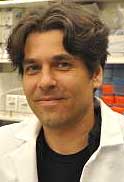Riverside, California
April 30, 2009Original:
http://newsroom.ucr.edu/news_item.html?action=page&id=2077
Crops and other plants are
constantly confronted with adverse environmental conditions,
lowering yield and costing farmers billions of dollars annually.
Plants use specialized signals, called stress hormones, to sense
difficult times and adapt to stressful conditions to enhance
survival.
Of the various stress hormones, abscisic acid (ABA), produced
naturally by plants, has emerged over the last 30 years as the
key hormone that helps plants cope with drought conditions.
Under such stress, plants increase their ABA levels, which helps
them survive the drought through a process not fully understood.
So critical is this endogenous chemical to plant survival that
researchers have engineered new drought-resistant crops by
tinkering with the ABA pathway.
For years, scientists have contemplated spraying ABA directly
onto crops to enhance their protection in times of stress. But
ABA is a costly, complicated and light-sensitive molecule that
has not found use in agriculture.
 Now
new research from the laboratory of Sean Cutler (photo), an
assistant professor of plant cell biology in the Department of
Botany and Plant Sciences at the
University of California, Riverside, suggests the
possibility of spraying stable synthetic chemicals on plants to
enhance stress tolerance during times of drought and improve
yield. Now
new research from the laboratory of Sean Cutler (photo), an
assistant professor of plant cell biology in the Department of
Botany and Plant Sciences at the
University of California, Riverside, suggests the
possibility of spraying stable synthetic chemicals on plants to
enhance stress tolerance during times of drought and improve
yield.
Using a method called chemical genomics, pioneered by UC
Riverside researchers for studying plant biology, Cutler
identified pyrabactin, a new synthetic chemical that turns on
the ABA signaling pathway in Arabidopsis, a small flowering
plant used widely in plant biology laboratories as a model
organism.
His lab then used pyrabactin to fish out a receptor for ABA – a
highly controversial topic involving retractions of scientific
papers as well as the publication of papers of questionable
significance. A receptor is a protein molecule in a cell to
which mobile signaling molecules may attach. Usually at the top
of a signaling pathway, it functions like a boss relaying orders
to the team below that then executes particular decisions in the
cell.
"Scientists have been trying to solve the ABA receptor problem
for more than 20 years, and claims for ABA receptors are not
easily received by the scientific community," said Cutler, who
came to UCR in 2007 from the University of Toronto. "We screened
thousands of chemicals for one that mimics ABA. We found
pyrabactin activates some of the ABA receptors in plants and is
an excellent mimic of ABA. Moreover, unlike ABA, it is stable
and easy to make. It therefore suggests a highly effective
chemical strategy for improving plants' ability to survive under
low-water conditions, potentially benefiting farmers in
drought-prone areas worldwide."
Cutler's approach highlights the power of the chemical genetic
approach for uncovering new leads for agrichemistry and, in
turn, using those leads to understand a biological process.
"This is a striking example of how a chemical allowed us to
solve a problem that genetics has been struggling with," he
said. "Clearly, chemical genetics can be used to bypass some of
the limitations that slow down classical genetic analysis. Not
too long ago, the United Nations called for a 'blue revolution'
- the water equivalent of the green revolution - of improved
water management and sharing. We have proven that we can enlist
chemicals that modulate stress responses in crops as soldiers in
the blue revolution. Now our goal is to design the best chemical
soldiers possible."
Study results appear April 30 in Science Express and in the May
22 issue of Science
magazine.
Because of the prior questionable data in the ABA field, Cutler,
the research paper's lead author, took the unusual step of
sharing his data with key competitors and turning them into
collaborators before publishing the results. Several labs
working in the ABA signaling field tested the ABA receptor that
Cutler's group identified, and validated his results. Scientists
from these labs are co-authors of the research paper.
"Several high-profile papers have tried to claim discovery of
ABA receptors but their research could not stand the test of
time, and these papers were ultimately withdrawn," said Natasha
Raikhel, the director of UCR's Center for Plant Cell Biology, of
which Cutler is a member. "I believe this time, Dr. Cutler and
his team have isolated a true ABA receptor."
Next in the research, Cutler and collaborator Brian Volkman of
the Medical College of Wisconsin will work on deducing the
structure of receptor-bound ABA and use this information to
guide the design of new chemicals that turn on the ABA signaling
pathway. Cutler and collaborators also plan to further
understand how the ABA receptors affect plant physiology.
Cutler was joined in the research by colleagues at UCR; the
University of Toronto, Canada; UC San Diego; Universidad
Politecnica, Spain; University of Ontario Institute of
Technology, Canada; UC Santa Barbara; and the Medical College of
Wisconsin.
Grants from the Canadian Research Chair, the Natural Sciences
and Engineering Research Council (Canada), the National Science
Foundation and the National Institutes of Health funded the
five-year study.
The University of California, Riverside is a doctoral
research university, a living laboratory for groundbreaking
exploration of issues critical to Inland Southern California,
the state and communities around the world. Reflecting
California's diverse culture, UCR's enrollment of about 17,000
is expected to grow to 21,000 students by 2020. The campus is
planning a medical school and has reached the heart of the
Coachella Valley by way of the UCR Palm Desert Graduate Center.
The campus has an annual statewide economic impact of more than
$1 billion.
Original:
http://newsroom.ucr.edu/news_item.html?action=page&id=2077
|
|